
We love keeping up with the photos and videos from your fabulous bike tour!
Give us a follow on Instagram at @bikespaintours, and tag us in the posts from your trip.
Please leave your luggage in the hotel reception each morning (by 9am at the latest) so that it can be transferred to your next hotel. Make sure that your luggage is clearly labelled with the nametag provided. In case of any issues with the luggage transfer, please call Edgar on (+34) 616 53 45 00.
Your bike fitting is scheduled for May 20th at 4:30pm at Hotel BQ Augusta, your hotel in Palma. Our local contact will meet you in the hotel reception. In case of any issue please contact Edgar at +34 616 53 45 00
Call the Bike Spain Tours office on +34 915 590 653, or out of office hours call +34 677 356 586. We will get you where you need to be and get you the help you need.
Please be aware that Spaniards follow a very particular routine in terms of their daily meals, and this is often strictly enforced by restaurant opening hours, especially in small towns!
You can expect restaurants to be open for lunch from approximately 1:30pm – 4pm. Many places will offer a menú del día: a set menu with 2/3 options for each course, usually including a drink, bread and dessert or coffee. Remember that lunch is the main meal of the day in Spain.
Dinnertime in Spain is any time from 8pm onwards. Dinner in Spain is typically a lighter meal.
Monday, 20th May: Palma de Mallorca
Arrival Day
Accommodation: Hotel BQ Augusta
4:30pm: Bike fitting at Hotel BQ Augusta. In case of any issues, please contact Edgar on +34 616 53 45 00.
At leisure in Palma de Mallorca
The capital of the island is located in the bay of the same name and enjoys an excellent climate all year round (with an average annual temperature of 17.9° C). Known for its sun and beach tourism, it also has an attractive historic quarter. The city’s beautiful monuments are surrounded by fishing boats, pine forests and palm trees.
Eating and drinking in Palma de Mallorca
For an authentic local experience, we recommend dinner at one of Mallorca’s diverse gastromarkets. Santa Catalina market is very popular among mallorquines for tardeo: tapas and drinks in the afternoon and early evening. Upmarket Mercado de Olivar is a great choice for foodies, while trendy Mercat 1930, located right on the seafront, mixes gourmet local cuisine with international dishes.
Tuesday, 21st May: Palma de Mallorca – Ses Salines
Route: 63.4 km/39.4 miles
Elevation: +367 m/+1205 ft
Accommodation: Hotel Ca’n Bonico
Today, you’ll enjoy a beautiful flat ride to warm up your legs!
You’ll begin by cycling out of Palma and around the bay of the same name, and continue towards the southern part of the island, cycling through bucolic agricultural scenery, dotted with historic mills and farms. As you reach the sea, you’ll enjoy dramatic coastal views, historic lighthouses and military outposts, and plenty of opportunities to cool off on white sand beaches.
If you fancy a bit more cycling once you arrive in Ses Salines, you can visit the famous Platja Es Trenc, a beach renowned for its crystalline waters, or the Cabo Salinas lighthouse for fabulous ocean views.
Eating and drinking in Ses Salines
Bike shops: Vision Bike (S’Arenal, +34 971443602), Ciclos Mora (Colonia de Sant Jordi, +34 971656697)
Wednesday, 22nd May: Ses Salines – Artà
Route: 80.1 km/49.8 miles
Elevation: +925 m/+3034 ft
Accommodation: Hotel Forn Nou
On today’s route, you’ll enjoy hilly roads with very few cars, lovely landscapes and indigenous Mediterranean forests, as well as your first Mallorcan switchback climb!
You have two potential routes for today: along the cliffs of the coast, or through the flowery fields of inland Mallorca. Both are detailed below.
Just beyond the town of Felanitx, you’ll face a challenging climb up to the Sanctuary of San Salvador. From the top, you’ll be rewarded with spectacular views over southern Mallorca and the Balearic Sea!
If you would like to extend today’s route once you arrive in Artà (or the start of tomorrow’s route), you can add a beautiful extra climb of about 9km up to the Ermita de Betlem for fabulous views over the Bay of Alcúdia.
Eating and drinking in Artà
Bike shops: Ciclos Gomila (Felanitx, +34 971 82 41 65), Bicicletas Caldentey (Manacor; +34 971 835 944)
Thursday, 23rd May: Artà – Port de Pollença
Route: 42.4 km/26.3 miles
Elevation: +274 m/899 ft
Accommodation: Hotel Mar Calma
Today, you’ll explore the authentic Mallorcan inland before cycling along the beautiful Bay of Alcúdia, before reaching the ancient walled city of the same name. We highly recommend a stop here to take a stroll around the picturesque old town, and enjoy a fantastic lunch at Restaurant Celler Ca’n Costa Alcúdia (open daily 12:45pm – 3pm).
From Alcúdia, you’ll cycle along the Bay of Pollença before arriving in the popular seafront town.
At leisure in Port de Pollença
Explore the charming fishing village turned seaside resort that inspired Agatha Christie’s Problem at Pollensa Bay! Thanks to prohibitive building regulations, there is rarely a high-rise block in sight; just long swathes of sandy beach, lined by pine and palm trees, and a splendid array of cafes and restaurants.
Port de Pollensa is one of Mallorca’s main year-round hubs. The Sky team choose to base their pre-season camps in the area, and the town has evolved into a major base for cyclists wanting to make the most of the diverse array of northern routes.
Eating and drinking in Port de Pollença
Bike shops: Routier’s (Port Pollença, +34 619 346 644), Pro Cycling bikes (Port Pollença, +34 667 450 640), Bimont bike shop (Alcúdia, +34 971 544 964)
Friday, 24th May: Cap Formentor Loop
Route: 38.5 km/23.9 miles
Elevation: +1280 m/4199 ft
Accommodation: Hotel Mar Calma
Built by Italian engineer Antonio Parietti, the winding road that runs between Port de Pollensa and Cap Formentor commands astounding views at every turn. The challenging route and typical Mallorcan switchbacks are a cyclist’s dream. Away from the port, you’ll discover a rugged wilderness of great natural beauty. On a clear day, you might even see Menorca, some 40km in the distance.
Optionally, you can consider doing this ride in the evening, to watch the sun set into the ocean from the lighthouse.
Sunday, 26th May: Port de Pollença – Sa Calobra – Port de Sòller
Route: 47.6 km/29.6 miles
Elevation: +1090 m/3575 ft
Accommodation: Hotel Aimia
Remember to bring your ID with you today, as you will need to present this when you board the boat from Sa Calobra to Port de Sòller.
The pure climbing starts today. The UNESCO World Heritage Site of Sa Calobra and its fabulous switchback road, one of the most beautiful routes on the whole island, prove why Mallorca is a superlative cycling paradise. Enjoy an adrenaline-fulled 10km of descent down to the crystalline waters of Sa Calobra beach. The road includes more than ten 180º turns, and even a full 360º turn known as the nus de sa corbata (the necktie knot!), in which the road passes underneath itself!
If you have time once in Sa Calobra, we recommend a brief excursion on foot into the spectacular Torrent de Pareis canyon.
4:40pm: Departure by boat from Sa Calobra beach to Port de Sòller. Reservation number: 27303 (2 people and 2 bikes).
At leisure in Port de Sòller
The picturesque fishing village of Port de Sòller is beloved by locals and tourists alike for its beautiful surroundings, historic tram and fantastic seafood! Separated from the rest of Mallorca by the Tramuntana mountain range, past generations had to take to the water to make trade possible.
Eating and drinking in Port de Sòller
Bike shops: Tramuntana Tours (+34 971 632 799)
Tuesday, 28th May: Port de Sòller – Estellencs
Route: 43.8 km/27.2 miles
Elevation: +1100 m/3610 ft
Accommodation: Maristel Hotel and Spa
Today you will cycle along a coastal road with beautiful panoramic views of the north coast of Mallorca. Every village along the way is worth a stop for the different perspectives that they offer of the spectacular Sierra de Tramuntana mountain range.
Eating and drinking in Estellencs
Your hotel has its own excellent restaurant; however, if you would like to explore the town further, we recommend Montimar (open Tue, Wed and Fri – Sun 6:30pm – 10pm).
Bike shops: Quilòmetre Zero (Sòller, +32 653469686)
Wednesday, 29th May: Estellencs – Palma de Mallorca
Route: 74 km/46 miles
Elevation: +1664 m/5460 ft
Accommodation: Hotel BQ Augusta
Your final ride of the week is a stunning combination of coastal and inland cycling. The route takes you through the charming little villages of south-west Mallorca. We recommend the diversion to the picturesque coastal village of Saint Elm, a lovely spot with crystal clear water, surrounded by lush countryside.
Bike shops: Bimont bike shop (+34 971 731 866), Palma on Bike (+34 971 718 062).
Thursday, 30th May
Departure day
After breakfast, our services come to an end. We hope that you enjoyed discovering Mallorca with us!
BQ Augusta Hotel
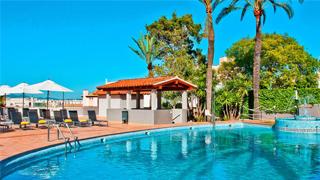
With its 74 modern and wide rooms this hotel is the ideal place to spend your Holidays in Palma de Mallorca.
Fully renovated in 2014 the BQ Augusta Hotel is in a residential area, very close to Palma de Mallorca’s Port and only 5 minutes from the city centre.
Hotel Can Bonico
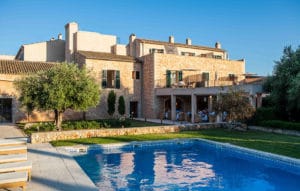
This hotel is located in the center of the town of Ses Salines, in the South of Mallorca. It is a typical Majorcan Stately house built in the thirteenth century.
Hotel Ca’n Bonico has been carefully converted and renovated into a luxury hotel. It was very important for us the fact of preserving the original structure and details. For example, the tower from the thirteenth century, which was used as a prison, has been turned into a private library. Ca’n Bonico is still owned by the Bonet family, direct descendants of the first owner, a noble knight who fought beside King James I
Hotel Mar Calma
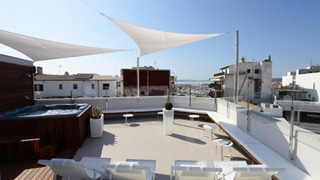
A first class small boutique hotel in Puerto de Pollença.
Mar Calma Hotel provides a unique experience in simple luxury and comfort in the heart of the old fishing village of Puerto Pollensa, now a chic, cosmopolitan resort on Mallorca’s privileged north coast.
The pedestrian roads around the central plaza offer a wide range of possibilities for spending an evening out. There are plenty of cafes and restaurants serving food from all over the world and you can find the emblematic Pine Walk at the end of the road.
Hotel Aimia Spa & Wellness
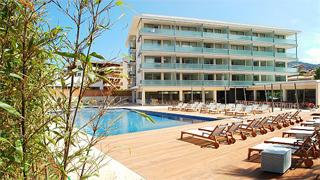
Looking towards the sea you will be able to rest, free of any other worry than choosing what to do during your stay in Majorca.
Our four-stored building is modern as well as simple, an ideal space for our guests to break away. The modern design and simple lines of our four-stored hotel provides an ideal space for our guests to evade and chill out.
Hotel Maristel & Spa
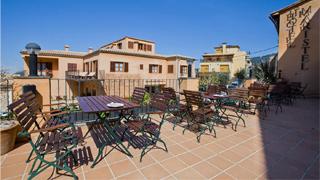
A corner of the world to lose yourself in.
Totally refurbished,Hotel Maristel & Spa is located on the Northern Coast of Majorca, in the Tramuntana Sierra, between mountains covered in forests and only 1 km from Estellencs Cove.A true heaven on earth within your reach, a place where time stops and mother nature marks the passage of time.
On a Bike Spain Tours vacation, understanding and abiding by the rules of safe cycling is vital.
You’re probably familiar with some common safety guidelines. Below are those that we follow at Bike Spain, and we ask that you follow them while traveling with us:
• Biking shorts
• Breathable, synthetic tops (short- and long-sleeved)
• Biking shoes
• Biking gloves and full-finger, wind-resistant gloves
• Helmets are mandatory!
• Wind & rain jacket
• Fleece jacket or warm vest/jacket
• Sunglasses
• Hat
• Bathing suit
• Sweater/jacket for cool evenings
• Walking shorts
• Comfortable walking shoes/sandals
• Evening wear
• Books about the area
• Travel alarm clock
• Camera
• First aid kit
• GPS
• Photocopies of your important documents
• Travel Insurance Certificate
• Airline tickets/Boarding Passes
• Passport/Visa (if required)
• Sunscreen and lip balm
• Required medications and their prescriptions
• Personal items and toiletries
• Mosquito repellent
• Expensive electronic items
• Expensive jewelry & family heirlooms
• Other valuables
Being on a bike tour shouldn’t mean constantly worrying about your bike breaking down. Nevertheless, bikes are machines, and issues can occur. Here’s what to look for if something doesn’t sound, feel, or work right.
ACCIDENTS: In case of an accident, keep calm, get off the road and go to a safe place (such as the hard shoulder) where you can evaluate the problem. If you suspect that you need medical care, call the Spanish emergency services on 112, explaining clearly where you are and what the problem is. Have your passport and your insurance documentation handy before calling. Please contact our office immediately after speaking with emergency services.
Remember that personal insurance it is not included on our self-guided tours. We offer an optional insurance policy. If you choose not to purchase this, please make sure that you keep own insurance documentation with you (including your passport).
The tour price does not include any roadside assistance with bicycle maintenance (e.g. flat tires) or any other taxi transfers during the tour. Any repairs that need to be caarried out on the bicycles that are not a result of negligence on Bike Spain Tours’ part will be paid for by the client.
HELMET: Cycling on the road in Spain without a helmet is illegal and unsafe; remember to wear your helmet at all times.
To check the weather before you leave on your trip, please take a look at current weather conditions at www.weatheronline.co.uk. For historical temperature and precipitation statistics visit www.weatherbase.com or take a look at the Spanish Meteorological website with detailed information per region (http://www.aemet.es/en/elclima/datosclimatologicos/valoresclimatologicos)
The history of Spain is a compendium of influences from the different cultures that have lived in the country. The first settlers on the Peninsula were the Celts and the Iberians. The Roman presence in Hispania lasted for seven centuries, during which time the basic borders of the Peninsula in relation to other European towns were set up. Many institutions were inherited from Rome such as the concept of family, Latin as a language, religion and law. At the start of the 5th century new settlers from the North arrived and settled on the Peninsula: the Visigoths in the interior and the Swabians on the West. The decomposition of the Visigoth state apparatus would lead to the successive infiltration of Arab and Berber troops from the other side of the Straits of Gibraltar at the beginning of the 8th century. In the middle of the 8th century the Muslims had completed occupation and Cordoba became the center of the flourishing Andalusian state. The Arab presence in Spain would last for almost seven centuries and leave an indelible mark on the Spanish cultural heritage.
Following a long period of peaceful coexistence, the small Christian strongholds in the North of the Peninsula took on a leading role in the Reconquest, which ended with the capture of Granada in 1492 under the reign of the Catholic King and Queen, traditionally considered the founders of peninsular unity and the imperial management of the Spanish revival. The 16th century represents the zenith of Spanish hegemony in the world, a process that would last until the middle of the 17th century. Following the death of Charles II, the last of the Austrians, who died without having had children, Phillip V inaugurated the dynasty of the Bourbons of Spain.
The crisis of the Old Order opened the doorway to the Napoleonic invasion. The War of Independence was a war against the French invasion, but also a revolutionary war due to the decisive involvement of the people and the clear formation of a national consciousness that would later shape the 1812 Constitution. The Courts of Cadiz thereby enacted one of the first Constitutions of the world which ratified that sovereignty would reside in the nation. The conflict between liberalists and absolutists, or in other words, between two different ways of perceiving the establishment of the state, would be one of the longest Spanish conflicts throughout the 19th century.
The ballot box is introduced into Spain and with it the first democratic experience of the 20th century: the second Republic, a brief attempt to introduce the reformations the country needed, frustrated by General Franco’s military rising and the outbreak of the Civil War in 1936. The military victory of General Franco gave way to a long dictatorial period that would last until 1975. Following his death, the Spanish peacefully made the transition from dictatorship to democracy in a process known as ‘the Spanish model’. Don Juan Carlos I, as King of the Spanish people, became the chief of a social and democratic state of law, which molded the Constitution of 1978.
More information…? Should you be interested in a specific theme, please check here, you will find many info about culture, environmental issues, nature, society, geography and politics.
In Spain you have exquisite and innovative dishes with the guarantee of internationally prestigious chefs. The highest quality products from the best producers, recipes combining popular tradition with artistic creation and offer you exciting, new flavors. Spain’s culinary revolution, headed by master chefs like Ferrán Adriá, Arzak and Berasategui turns the pleasure of good food into a luxury for the senses that is at its finest when savored in Spain.
Spanish cuisine is nowadays recommended in the finest restaurants, heralded by the most prestigious critics and demanded by millions of consumers over the world. It has gone through a real revolution, which, in the time of a few short years, has put Spain at the top of international cuisine. With traditional styles as the basis, a modern, innovative cuisine has developed, identified by the use of quality products and by the creativity of its chefs.
To read more about Spain’s cuisine
Info
About UsContact Info
Plaza de la Villa 1,
28005 Madrid
+34 915 590 653
info@bikespain.com
